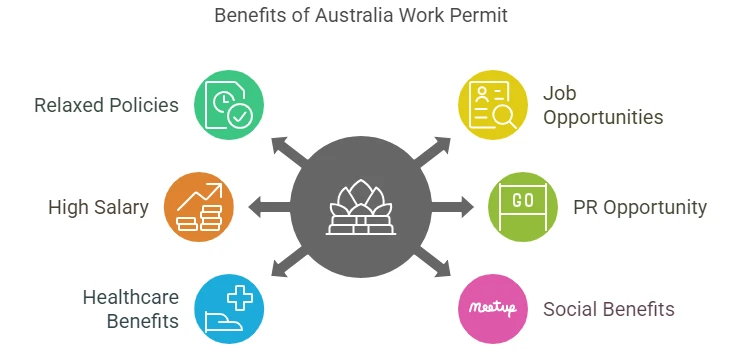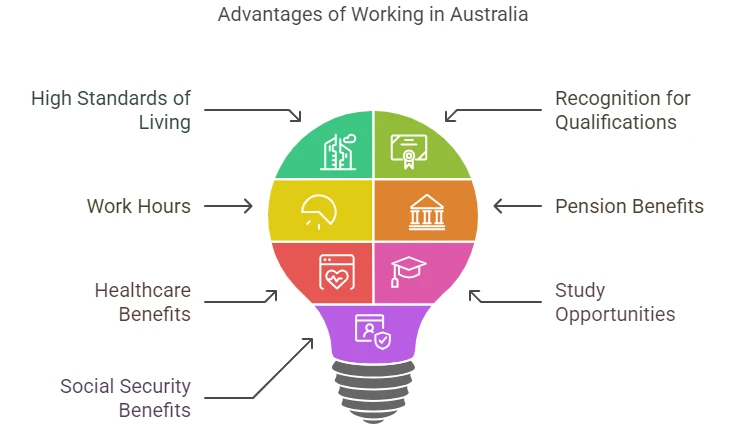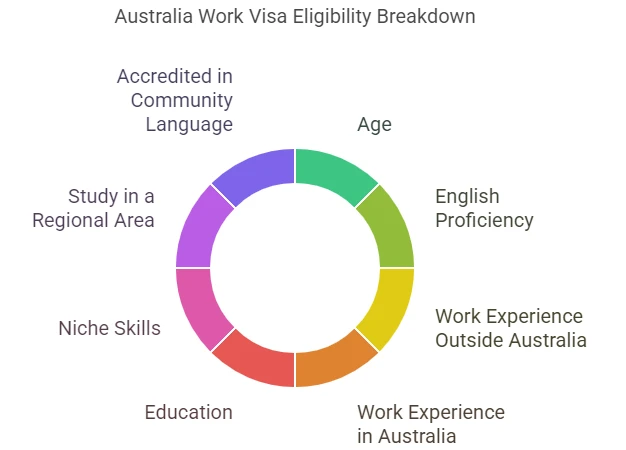Why Australia Work Permit?
- Relaxed Policies for Skilled Workers
- 800,000 Job opportunities
- Earn an average annual salary of AUD 85,000 - 95,000
- Great chance to get an Australia PR
- Access to Healthcare benefits
- Enjoy social benefits

Australia Work Permit
A work permit in Australia is an important document issued by the Australian government that allows foreign nationals to work there. The Australian work permit validates your right to work legally in the country. There are two types of Australian work visas, temporary and permanent work visas and the type of visa you apply for will depend on your requirements and employment type.
Australia Work Visa for Indians
The Australian work visa for Indians helps to explore diverse work opportunities and access to settle in the Land Down Under. As one of the world’s most dynamic countries, Australia has an immense requirement for skilled talent. Make the most of this opportunity by applying for an Australian Work Visa. Having years of experience in Australian immigration processes, Y-Axis is the best consultant to launch your career in Australia.
* Want to work in Australia? Start here to get expert guidance with Migrate to Australia Flipbook.
Work in Australia for a high standard of living
There are two types of Australian work visas. Temporary work visas and Permanent Work Visas. These are designed to encourage overseas applicants to obtain sponsorship through an employer or to secure the nomination. Many skilled professionals choose to work in Australia because of the career growth, employment opportunities, and salaries offered.
Australia Permanent Work Permits
|
Permanent work permit type |
Description |
|
Skilled workers nominated by their employers will be eligible live and work in the country permanently |
|
|
Skilled workers nominated by their employer in regional Australia will be eligible live and work in the country permanently |
|
|
This visa is eligible for invited workers and New Zealand citizens who possess the required skills needed by Australia to live and work permanently |
|
|
Nominated skilled workers can live and work in Australia as permanent residents |
|
|
This is a permanent visa for individuals with a globally recognized record of exceptional achievement in a profession, sport, the arts, or academics and research |
Australia Temporary Work permits
|
Temporary work permit type |
Description |
|
Individuals can work between two to four years, based on the requirement of the employee. To obtain this visa, Australian businesses would have to show they are facing a shortage of local talent for the job. Applicants should have previous work experience of at least two years and should be under 45 years |
|
|
This is a temporary visa for skilled workers who want to live and work in regional Australia |
|
|
This visa is for short-term, highly-specialized work in the country |
|
|
This visa is eligible for individuals between the ages of 18 – 30, allowing them to take up short-term jobs in Australia while on a holiday. The visa is valid for 12 months |
Australia's New Core Skills Occupation List (CSOL)
Australia released a new Core Skills Occupation List (CSOL), replacing Subclass 482 Temporary Shortage Visa. The CSOL will apply to the Direct Entry Stream of the Subclass 186 visa and the Core Stream of the new Skills In Demand visa.
Click on this page for the Core Skills Occupation List (CSOL) to work in Australia.
Benefits of an Australia Working Visa
Below are the benefits of working in Australia:
- High standards of living
- Recognition for your qualifications
- Work 38.5 hours/week
- Access to pension benefits
- Healthcare benefits
- Great opportunity to study
- Social security benefits

Jobs in Australia
As per the recent reports, there are 8 lakh jobs in Australia. The top-in-demand occupations in Australia of various sectors and the average annual salaries paid are mentioned in the table below:
| Occupation | Annual Salary in (AUD) |
| IT | $99,642 – $ 115, 000 |
| Marketing & Sales | $84,072 – $103,202 |
| Engineering | $92,517 – $110,008 |
| Hospitality | $60,000 – $75,000 |
| Healthcare | $101,569- $169279 |
| Accounting & Finance | $77,842 – $92,347 |
| Human Resources | $80,000 – $99,519 |
| Construction | $72,604 – $99,552 |
| Professional and Scientific Services | $90,569 – $108,544 |
Jobs in Australia for Indians
It is always challenging for Indians who are willing to move to Australia or are planning to settle in Australia. This is usually because of the unawareness of immigrants’ jobs in demand.
Australia, being one of the most strong and dynamic countries, is one of the popular destinations for Indian students and professionals who are looking for career growth. Australia has a strong economy with a fixed political climate, clean nature and outstanding growth, making it an attractive destination for job seekers. Many individuals who migrate to Australia find it difficult to find a stable job there.
How to get a job in Australia from India in 2024
Step 1: Research the Australian job market
Whether looking for on-site or remote jobs in Australia, you must first begin with proper research on the Australian job market. Searching for job opportunities within sectors with higher growth potential will assure faster career growth. There are plenty of Australian job portals where you can research between different sectors.
Step 2: Build an ATS-friendly resume
Once you have identified the sector that matches your qualifications and work experience, the next step is to prepare a powerful resume and cover letter.
Most employers in Australia are using ATS (Applicant Tracking System) to filter the right candidates. This software makes the hiring process easier; all the resumes are scanned. Application Tracking System filters the applications based on specific keywords, resume formats profiles with photos, proper alignment, etc. Always prepare a resume that is ATS-friendly.
Step 3: Apply for jobs
Once your resume is ready, apply for jobs on Australian job portals and the company’s official website. Additionally, you can reach out to HR firms and a few trusted recruitment agencies to make your process faster. These firms offer paid services, so it is worth taking their job assistance.
Step 4: Apply for a suitable visa
Another important step is to get a job in Australia from India. You must select the right visa category based on your preferences and initiate the visa application process.
The application process and the eligibility criteria may differ based on the type of visa you are selecting. Therefore, understand your requirements before proceeding with your application.
Step 5: Get your visa stamped
After your visa application gets approved, you can move forward with other immigration formalities. Once immigration formalities are done, get your visa stamped, schedule your flight, and you are ready to move to Australia.
Eligibility to Work in Australia
The eligibility criteria for an Australia Work Visa include the following:

| Category | Maximum Points |
| Age (25-32 years) | 30 points |
| English proficiency (8 bands) | 20 points |
| Work Experience outside Australia (8-10 years) | 15 points |
| Work Experience in Australia (8-10 years) | 20 points |
| Education (outside Australia) – Doctorate degree | 20 points |
| Niche skills such as Doctorate or master’s degree by research in Australia | 10 points |
| Study in a regional area | 5 points |
| Accredited in community language | 5 points |
| Professional year in a skilled program in Australia | 5 points |
| State sponsorship (190 visa) | 5 points |
| Skilled spouse or de facto partner (Age, Skills & English language requirements to be met) | 10 points |
| Spouse or de facto partner with ‘competent English’ (No need to meet Skills requirement or age factor) | 5 points |
| Applicants without a spouse or de facto partner or where a spouse is an Australia citizen or PR holder | 10 points |
| Relative or regional sponsorship (491 visa) | 15 points |
Australia Work Visa Requirements
The Australian government devised the General Skilled Migration program (Skillselect) in 2013 to replace the Australian skilled worker visas. The Skillselect is designed to assess the skills of applicants under a point-based system so that immigrants with the right skills can be selected. The applicants are given points under the following criteria:
- Age: Those between the ages of 25 and 32 score the most points while those above 45 do not gain any points.
- English language proficiency: Applicants are required to take the IELTS test. If they score 8 bands or more, you get 20 points.
- Skilled employment: If you have experience in an occupation that is listed in the Skilled Occupations List you will get points based on the years of experience. 20 is the maximum points you can gain.
- Educational qualification: To get points under this category, your qualification must be related to your nominated occupation. 20 points is the maximum you can score if you have a doctorate while a bachelor’s or master’s degree will give you 15 points.
- Australian qualifications: You can get five points if you have an Australian qualification from an Australian educational institute.
- Regional study: You can gain an additional 5 points if you have lived and studied in regional Australia.
- Community language skills: You will gain another 5 points if you have translator/ interpreter level skills in one of the country’s community languages.
- Spouse/partner skills and qualifications: If you have included your spouse/partner in the application and he/she is not an Australian resident/citizen, then their skills are eligible to be counted towards your total points. You will gain an additional five points if your spouse/partner must meet the basic requirements of the Australian General Skilled Migration.
- Professional year: You will stand to gain another 5 points if you have completed a Professional Year in Australia for a period of at least 12 months in the last four years from either ACS/CPA/CAANZ/IPA/Engineers Australia. You must score at least 65 points to qualify for a visa under the General Skilled Migrant Program.
- Skilled Independent Visa: You can be eligible for this visa if you have the necessary skills and qualifications for specific occupations listed in the Skilled Occupation List (SOL). This visa does not require the sponsorship of an employer. You can use the SkillSelect tool to find out if your skills are in demand.
- Employer Nomination Scheme: Under this scheme, a permanent work visa is given to workers sponsored by their companies.
- TSS Visa (Temporary Skill Shortage): Under this visa, individuals can work between two to four years, depending on the employee’s requirement. Applicants should have a minimum of two years’ work experience and should be below 45 years. Companies taking employees on this visa must pay them the market salary.
Australia Skills Assessment
Skill assessment is an integral part of Australian work visa application process. One must select an occupation that is listed in Australia’s Occupational Demand List. This list will mention occupations that face a skill shortage in the country. Every occupation in the list has its own skill-assessing authority. The ACS (Australian Computer Society) assesses occupations under IT and Computers. Trade occupations are assessed by the TRA (Trade Recognition Australia) or the VETASSESS (Vocational Educational and Training Assessment Services).
An applicant should have a positive skill assessment for the next steps in the Australian work visa process. To get their skill assessment done, candidates must meet the required conditions outlined by the assessing authority, which is evaluating their occupation. The candidate should have the related qualifications and experience to get a positive assessment.
The first requirement for a positive skill assessment is that your occupation must be related to your work experience. If there is a mismatch, you will not get the required points. The candidate must submit every additional detail requested by the assessing authority.
Looking for Inspiration
Explore what Global Indians have to say about Y-Axis in shaping their future
Frequently Asked Questions
